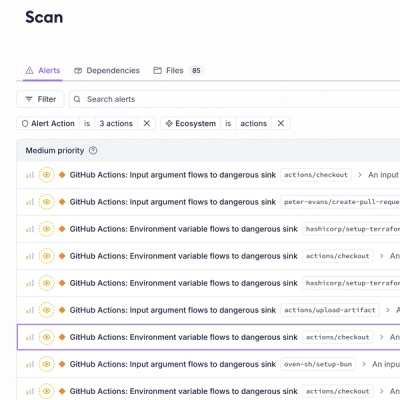
Product
Introducing GitHub Actions Scanning Support
Detect malware, unsafe data flows, and license issues in GitHub Actions with Socket’s new workflow scanning support.
Convenience functions for working with Census APIs: Statistics, Cartographic GeoJSON, lat/lng -> FIPS, and other niceties.
Breaking Change (November 2022)
Due to free Dynos - which were used to proxy CORS requests - being deprecated by Heroku, pre
2.3versions of CitySDK will cease to work client-side.Additionally, the migration to AWS has forced us to migrate core config files which cause breaks in server-side code in the near future
Please update to the latest version of CitySDK (
2.3) to fix
shadow-cljs build tool)xforms library)npm install citysdk
Starting with v2.3.0, CitySDK ships as an ESM export
Migration:
// 2.2.x or below
const census = require('citysdk')
// 2.3.x or above
import census from 'citysdk'
citysdk FunctionCitySDK exports a single function, which takes two arguments:
census function and applied to the responseBrief overview of each argument parameter that can be passed into CitySDK
| Parameter | Type | Description | Geocodes | Stats | GeoJSON | GeoJSON with Stats |
|---|---|---|---|---|---|---|
vintage | int/str | The reference year (typically release year) of the data | ✔ | ✔ | ✔ | ✔ |
geoHierarchy | object | The geographic scope and hierarchical path to the data | ✔ | ✔ | ✔ | ✔ |
sourcePath | array | Refers to the Census product of interest | ✔ | ✔ | ||
values | array | For statistics, values request counts/estimates via variable IDs | ✔ | ✔ | ||
geoResolution | str | Resolution of GeoJSON ("20m", "5m", and "500k" available) | ✔ | ✔ | ||
predicates | object | Used as a filter available on some values | ✔* | ✔* | ||
statsKey | str | You may request a key for Census' statistics API here | ✔** | ✔** |
* : optional ** : optional for < 500 requests daily
With the exception of "microdata" statistics (not yet
available via Census' API), all Census data is aggregated to
geographic areas of different sizes. As such, all of Census'
API's require a set of/unique geographic identifier(s) to
return any data (AKA: FIPS). Given that these
identifiers are not common knowledge, the CitySDK provides a
way for the user to identify their geographic scope of
interest using a geographic coordinate (lat + lng).
Under the hood, this functionality calls the TigerWeb Web
Mapping Service with the lat & lng provided and pipes
the resulting FIPS codes into your options argument with the
appropriate GEOIDs for identifying your geographic area of
interest.
For a list of geographies currently available for geocoding with this feature, see the Geographies Available by Vintage section below.
There are two ways to scope your geography using this functionality:
RETURN TYPE: JSON
You may pass a {"lat" : <float>, "lng" : <float>} object as the first and only value for the
geoHierarchy key:
import census from 'citysdk'
census(
{
vintage: 2015, // required
geoHierarchy: {
// required
county: {
lat: 28.2639,
lng: -80.7214,
},
},
},
(err, res) => console.log(res)
)
// result -> {"vintage":"2015","geoHierarchy":{"state":"12","county":"009"}}
Notice how the function prepends an additional geographic
component ("state" : "12") to the options object. In order
to fully qualify the geographic area (GEOID) associated with
the county, the state is needed. In this example the fully
qualified GEOID would be 12009 with the first two digits
(12) qualifying the state and 009 qualifying the county
within that state. This appropriate geographic hierarchy
creation is handled by the function for you.
RETURN TYPE: JSON
import census from 'citysdk'
census(
{
vintage: '2015', // required
geoHierarchy: {
// required
state: {
lat: 28.2639,
lng: -80.7214,
},
county: '*', // <- syntax = "<descendant>" : "*"
},
},
(err, res) => console.log(res)
)
// result -> {"vintage":"2015","geoHierarchy":{"state":"12","county":"*"}}
All Census-defined geographic areas are composed of Census "Blocks". Some of these composed areas - themselves - compose into higher-order areas. These nested relationships between certain geographic areas allows the Census data user to request all descendants of a particular type.
geoHierarchy
object to an ordered set, so this part of your request
object must be in descending hierarchical order from
parent -> descendant. E.g. - in the above - an object
that contained {"county" : "*", "state" : {"lat" <lat> "lng" <lng>}} will not work.geoHierarchy object ("county" : "*"). It is
important to use the "*" expression signifying that you
want all of the specified level of descendants within
the geography for which you supply a coordinate. No other
expression will work."*") geographies, the Census API can
accept a skipped or "leapfrogged" wildcard. For example:geoHierarchy: {
state: "01",
tract: "*"
}
However, the fully qualified geographic id requires an
intermediary scope (in the above case county). You can
tell when an intermediary scope has been skipped by checking
the payload of the stats request who's URL is logged by
CitySDK.
Another indicator that you might be hitting this issue is if you get back an empty features list in your GeoJSON:
{ type: 'FeatureCollection', features: [ ] }
The solution to this problem is to add the skipped scope as a null property, e.g.:
geoHierarchy: {
state: "01",
county: null, // <- leapfrog fix
tract: "*"
}
This parameter set will call the Census Statistics API and reformat the results with a couple highly requested features:
There are two ways to request Census statistics using
citysdk:
values of estimates and other statistical
values (required)predicates (optional)For both of these options, a sourcePath needs to be
supplied. This is the fully qualified path to the product.
For more information about how to find the sourcePath to
your product of interest, go to the Developers' Microsite
and - in any of the examples of making a call - take the
path between <vintage>/ and the ?get. For example, for
American Community Survey 1-year you'll the first example
(2017) shows:
https://api.census.gov/data/2017/acs/acs1?get=NAME,group(B01001)&for=us:1
└─┬─┘└───┬────┘
vintage sourcePath
The corresponding sourcePath for this endpoint is ["acs", "acs1"]
"values" by ID:RETURN TYPE: JSON
census(
{
vintage: 2015, // required
geoHierarchy: {
// required
county: {
lat: 28.2639,
lng: -80.7214,
},
},
sourcePath: ['cbp'], // required
values: ['ESTAB'], // required
},
(err, res) => console.log(res)
)
// result -> [{"ESTAB":13648,"state":"12","county":"009"}]
Here, we added the parameters for sourcePath (the path to
the survey and/or source of the statistics) and values
(the identifiers of the statistics we're interested in). By
including these parameters within your argument object, you
trigger the census function to get statistics. This
"deploy on parameter set" strategy is how the census
function determines your intent.
You're probably thinking: "How am I supposed to know what
codes to use inside those parameters?" - or - "Where did
that "cbp" & "ESTAB" stuff come from?" The data sets
covered by the CitySDK are vast. As such, this is the
steepest part of the learning curve. But, don't worry, there
are a number of different resources available to assist you
in your quest:
"values" by ID (with key):RETURN TYPE: JSON
census(
{
vintage: 2015, // required
geoHierarchy: {
// required
county: {
lat: 28.2639,
lng: -80.7214,
},
},
sourcePath: ['cbp'], // required
values: ['ESTAB'], // required
statsKey: '<your key here>', // required for > 500 calls per day
},
(err, res) => console.log(res)
)
// result -> [{"ESTAB":13648,"state":"12","county":"009"}]
predicates:RETURN TYPE: JSON
predicatesPredicates are used to create a sub-selection of statistical values based on a given range or categorical qualifyer.
census(
{
vintage: '2017',
geoHierarchy: {
state: '51',
county: '*',
},
sourcePath: ['acs', 'acs1'],
values: ['NAME'],
predicates: {
B01001_001E: '0:100000', // number range separated by `:`
},
statsKey: '<your key here>',
},
(err, res) => console.log(res)
)
/* result:
[
{
"NAME":"Augusta County, Virginia",
"B01001_001E" : 75144,
"state":"51",
"county":"015"
},
{
"NAME":"Bedford County, Virginia",
"B01001_001E" : 77974,
"state":"51",
"county":"019"
},
...
]
*/
If you'd like to use "timeseries" data, you may do so for
statistics only. Mapping timeseries data is currently
unsupported. Note that many timeseries products rely heavily
on the "predicates" option:
'timeseries" data:RETURN TYPE: JSON
census(
{
vintage: 'timeseries', // required
geoHierarchy: {
// required
us: '*',
},
sourcePath: ['asm', 'industry'], // required
values: ['EMP', 'NAICS_TTL', 'GEO_TTL'],
predicates: { time: '2016', NAICS: '31-33' },
},
(err, res) => console.log(res)
)
/* result:
[{"EMP": 11112764,
"NAICS_TTL": "Manufacturing",
"GEO_TTL": "United States",
"time": "2016",
"NAICS": "31-33",
"us":"1"}]
*/
For some sources (e.g., the American Community Survey), most
of the values can also be used as predicates, but are
optional. In others, (e.g., International Trade),
predicates are a key part of the statistical query. In
either case, at least one value within values must be
supplied.
You can also use the CitySDK to retrieve Cartographic
Boundary files, which have been translated into GeoJSON. The
only additional parameter you'll need to know is a simple
declaration of geoResolution of which there are three
options:
| Resolution | Map Scale | Benefits | Costs |
|---|---|---|---|
| 500k | 1:500,000 | Greatest variety of summary levels & Most detailed | largest file sizes |
| 5m | 1:5,000,000 | Balance between size and detectable area size | lowest variety of available area types |
| 20m | 1:20,000,000 | Smallest file sizes | lowest level of detail |
See the full available Cartographic GeoJSON in the Geographies Available by Vintage section
fsRETURN TYPE: JSON STRING
const fs = require('fs')
census(
{
vintage: 2017,
geoHierarchy: {
'metropolitan statistical area/micropolitan statistical area': '*',
},
geoResolution: '500k', // required
},
(err, res) => {
fs.writeFile('./directory/filename.json', JSON.stringify(res), () => console.log('done'))
}
)
This would convert the returned geojson to a string, which allows it to be saved via Node.js' fileSystem API.
census(
{
vintage: '2017',
geoHierarchy: {
state: '51',
county: '*',
},
geoResolution: '500k', // required
},
(err, res) => console.log(res)
)
It's important to note that - when querying for these GeoJSON files - you may retrieve a larger area than your request argument specifies. The reason for this is that the files are (currently) stored at two geographic levels: National and by State. Thus, the query above will attempt to resolve, at the state level, all counties, but because counties are stored at the national level in vintage 2017, all the counties in the US will be returned by this query.
If you wish to get back only those geographies you
specify, you may do so by using the last and perhaps most
useful feature included in the v2.0 release: Getting GeoJSON
with statistics included within the "FeatureCollection"
properties object!
RETURN TYPE: JSON
There are a number of reasons you might want to merge your statistics into their GeoJSON/geographic boundaries, all of which are relevant when seeking to map Census data:
values)A more dynamic example of using stats merged with GeoJSON on the fly with citysdk can be found
here:
Type in a county name and see the unweighted sample count of the population (ACS) for all the Block Groups within that County.
Use Chrome for best results (mapbox-gl geocoder caveat)
census({
vintage: '2017',
geoHierarchy: {
county: '*',
},
sourcePath: ['acs', 'acs5'],
values: ['B19083_001E'], // GINI index
statsKey: '<your key here>',
geoResolution: '500k',
})
In this example, we use citysdk to create the payload and
then save it via Nodes fs.writeFileSync and then serve
it via a Mapbox-GL map.
census({
vintage: '2017',
geoHierarchy: {
'zip-code-tabulation-area': '*',
},
sourcePath: ['acs', 'acs5'],
values: ['B19083_001E'], // GINI index
statsKey: '<your key here>',
geoResolution: '500k',
})
This is a very large request, in fact, one of the largest
you could possibly make in a single citysdk function call.
It is so large, in fact that it currently only works on Node
and only if you increase your node --max-old-space-size=4096. With large merges (such as all
counties or zctas), it is recommended not to try to use
citysdk dynamically, but - rather - to munge your data
before hand with citysdk and then serve it statically to
your mapping library, as was done here:
// Call the WMS only
{
"vintage": 2014,
"geoHierarchy": { "state": { "lat": 28.2639, "lng": -80.7214 }, "county": '*' }
}
// Getting the stats for a single county filtering out any county with population under 100,000
{
"vintage": 2016,
"geoHierarchy": { "county": { "lat": 28.2639, "lng": -80.7214 } },
"sourcePath": [ "acs", "acs5" ],
"values": [ "B01001_001E" ]
"predicates": { "B00001_001E": "0:100000" },
}
// strings are valid as vintages as well
{
"vintage": "2015",
"geoHierarchy": { "county": { "lat": 28.2639, "lng": -80.7214 } },
"sourcePath": [ "cbp" ],
"values": [ "ESTAB" ]
}
// Just geojson for all the counties within a state located by a given coordinate
{
"vintage": 2014,
"geoHierarchy": { "state": { "lat": 28.2639, "lng": -80.7214 }, "county": "*" },
"geoResolution": "500k"
}
// For large request expect to have to increase `node --max-old-space-size=4096`
{
"vintage": 2016,
"sourcePath": [ "acs", "acs5" ],
"values": [ "B25001_001E" ],
"geoHierarchy": { "zip-code-tabulation-area": "*" },
"geoResolution": "500k"
}
The Census Bureau publishes both high and low accuracy geographic area files to accommodate the widest possible variety of user needs (within feasibility). Cartography Files are simplified representations of selected geographic areas from the Census Bureau’s Master Address File/Topologically Integrated Geographic Encoding and Referencing (MAF/TIGER) system. These boundary files are specifically designed for small scale thematic mapping (i.e., for visualizations).
For a while now, we have published our cartography files in
the .shp format. More recently, we expanded our
portfolio of available formats to .kml. It is with this
release that we follow suit with the community at large to
release these boundaries in .json (GeoJSON) format.
The most comprehensive set of geographies and vintages can
be found within the 500k set. Some vintages - 103
through 110 - are references to sessions of Congress and
only contain a single geographic summary level:
"congressional district" The following tables represent
the availability of various geographic summary levels
through the remaining vintages:
| Geographic Area Type | 1990 | 2000 | 2010 | 2012 | 2013 - 2015 | 2016 - 2021 |
|---|---|---|---|---|---|---|
"alaska native regional corporation" | ✔ | ✔ | ✔ | ✔ | ✔ | |
"american indian-area/alaska native area/hawaiian home land" | ✔ | ✔ | ✔ | ✔ | ✔ | |
"block group" | ✔ | ✔ | ✔ | ✔ | ✔ | |
"combined new england city and town area" | ✔ | ✔ | ||||
"combined statistical area" | ✔ | ✔ | ✔ | |||
"congressional district" | ✔ | ✔ | ✔ | ✔ | ||
"consolidated cities" | ✔ | ✔ | ✔ | ✔ | ||
"county" | ✔ | ✔ | ✔ | ✔ | ✔ | |
"county subdivision" | ✔ | ✔ | ✔ | ✔ | ✔ | |
"division" | ✔ | ✔ | ✔ | ✔ | ||
"metropolitan statistical area/micropolitan statistical area" | ✔ | ✔ | ✔ | |||
"new england city and town area" | ✔ | ✔ | ✔ | |||
"place" | ✔ | ✔ | ✔ | ✔ | ✔ | |
"public use microdata area" | ✔ | ✔ | ||||
"region" | ✔ | ✔ | ✔ | ✔ | ||
"school district (elementary)" | ✔ | ✔ | ✔ | |||
"school district (secondary)" | ✔ | ✔ | ✔ | |||
"school district (unified") | ✔ | ✔ | ✔ | |||
"state" | ✔ | ✔ | ✔ | ✔ | ✔ | |
"state legislative district (lower chamber)" | ✔ | ✔ | ✔ | ✔ | ✔ | |
"state legislative district (upper chamber)" | ✔ | ✔ | ✔ | ✔ | ✔ | |
"tract" | ✔ | ✔ | ✔ | ✔ | ✔ | |
"urban area" | ✔ | ✔ | ✔ | ✔ | ✔ | |
"us" | ✔ | ✔ | ✔ | |||
"zip code tabulation area" | ✔ | ✔ | ✔* |
* = not available until Dec 2020
FAQs
Convenience functions for working with Census APIs: Statistics, Cartographic GeoJSON, lat/lng -> FIPS, and other niceties.
The npm package citysdk receives a total of 316 weekly downloads. As such, citysdk popularity was classified as not popular.
We found that citysdk demonstrated a not healthy version release cadence and project activity because the last version was released a year ago. It has 1 open source maintainer collaborating on the project.
Did you know?

Socket for GitHub automatically highlights issues in each pull request and monitors the health of all your open source dependencies. Discover the contents of your packages and block harmful activity before you install or update your dependencies.

Product
Detect malware, unsafe data flows, and license issues in GitHub Actions with Socket’s new workflow scanning support.

Product
Add real-time Socket webhook events to your workflows to automatically receive pull request scan results and security alerts in real time.

Research
The Socket Threat Research Team uncovered malicious NuGet packages typosquatting the popular Nethereum project to steal wallet keys.